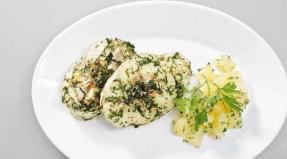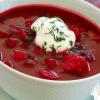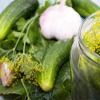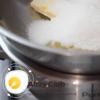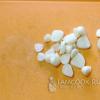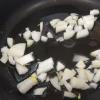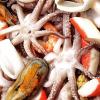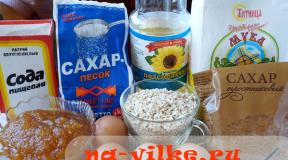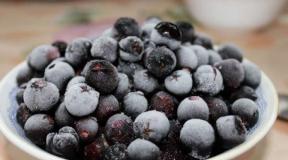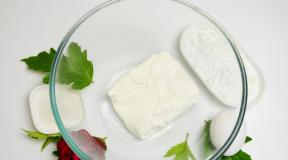Hake fish where it lives. What does hake fish look like?
Hake, or hake (Merluccius) is a dietary sea fish with tender white meat, in which there are few bones.
Description
Hake belongs to the genus of the hake family. It lives on the continental shelf of the Pacific and Atlantic oceans at a depth of 50 to 900 m. This silver-gray fish with a darkish back differs from other close relatives in the structure of the caudal fin, which is completely separate from the dorsal and anal. Another feature of the hake is that its lower jaw is longer than the upper. The fish is considered to be bottom, but for prey it rises to the intermediate and upper layers of ocean waters. Young individuals feed on crustaceans, but with age they become predators, and small fish appear in their diet, for example, anchovy, smelt. In turn, hake is a tasty prey for sea lions and small cetaceans. On average, the length of the fish is 50-70 cm, the weight reaches 3 kg, but sometimes large specimens - up to 1.5 meters in length - get into fishing nets. Hake spawns in summer. During one spawning season, one female lays about 400,000 eggs with a diameter of 0.8-1.2 mm. Hake live up to 20 years.
Application
Like many fish, hake is easily heat-treated: it is boiled, fried, stewed, baked. For cooks, this fish is good first of all because it has few bones; after cooking, the fillet plates are easily separated from the ridge. Hake meat is considered low-fat, so it can be used to prepare dietary dishes, for example, in. However, when baking fish, you need to “moisten” it with sauce or broth from time to time. Considering that hake meat is dryish, it is also better to fry it in batter or a thick layer. Hake makes excellent stuffing for fish cakes or whites. Steamed hake can be served with sour cream or cream sauce, as well as with herbs with a pronounced aroma (dill, parsley, cilantro). It is better to stew hake with vegetables in tomato, mustard or.
Composition and properties
Hake is literally crammed with useful substances, it contains calcium, phosphorus, iron, zinc, fluorine, sodium, sulfur, copper, molybdenum, nickel, manganese. For example, cobalt, chromium, and iodine contained in fish meat provide the body with these microelements by 200, 110 and 106.7 percent of the daily norm, respectively. Hake is also distinguished by a high content of vitamins - PP, C, A, E, B2, B1, B9, B6. Despite the reputation of being a "lean fish", hake is rich in omega-3 fatty acids, especially its caviar. The product helps to get rid of toxins, maintain normal blood sugar levels. It is no coincidence that it is recommended to be included in the diet of people suffering. Hake is also useful for hypertension, diseases of the nervous and cardiovascular systems.
Contraindications
Allergy to fish.
As cod is popular in Norway, hake is the number one fish in Spain and Portugal.
Calorie content and nutritional value of hake
Hake calorie - 86 kcal.
Hake nutritional value: proteins - 16.6 g, fats - 2.2 g, carbohydrates - 0 g.
Hake hit the tables of Soviet citizens after the cod catch in the Land of the Soviets fell sharply. Merluza (another official name for hake) was then considered the second grade and was not particularly favored, preferring the same cod, while European residents considered hake almost a delicacy. Nowadays, hake is actively imported from European countries and is used along with other white fish in various dishes, both as a whole and in the form of fillets.

Characteristic
Hake comes from the hake family. Hake can reach 1.5 m in length, and its minimum size is about 35 cm. Hake often has silvery scales, which darkens closer to the ridge and acquires a grayish tint. The eyes of the fish are quite large and occupy? the length of the head, and the lower jaw has a feature - it is longer than the upper one. In general, hake outwardly looks very threatening, like a real predator, so it is rarely seen in a store with a head.
The hake has two fins on its back. The first is three times shorter than the second dorsal fin and looks like a triangle. The anal fin is symmetrical to the second fin, and both of them rest against the tail, but they are not connected to each other. Hake is an omnivorous fish. In her youth, she can eat plankton and small crustaceans, but having matured and becoming a predator, hake begins to eat mackerel, herring and squid. Sometimes hake destroys its own fry.
As for reproduction, females from the fourth year of their lives begin to lay eggs at a depth of 100 m. For the entire season, and spawning continues from spring to autumn, hake reproduces about 400 thousand eggs. Hake live about 18-20 years.

Habitat
Hake mostly lives in the subarctic waters of the Pacific Ocean and the waters of the Atlantic at a depth of 200-1000 m. The fish leads a bottom lifestyle, and rises to the middle layers of the water mass during the spawning period. Hake came to Russia artificially. It was settled in the waters of the Black Sea, but most often hake is imported from European countries, the USA and Chile.
Varieties
Usually all fish are divided into marine and river inhabitants. So, hake belong to marine life. They themselves, in turn, have many varieties. Countries, off the coast of which different types of hake are found, as well as the waters of the oceans and seas, gave names to each species:
- the European species lives off the coast of northern European countries, as well as in the Black and Mediterranean Seas;
- the Argentine species is distributed off the southern coast of Brazil;
- the silvery species is more commonly seen in the coastal waters of the United States and Canada;
- the Chilean species lives off the western coast of South America;
- the New Zealand species is distributed off the coast of New Zealand;
- the Cape species was first seen in the waters of South West Africa.


It must be said that the Pacific hake is a fairly large marine life. Its weight is up to 10 kg, and its length is about 90 cm. This fish reaches puberty faster than all its relatives, but lives no more than 15 years. The Pacific hake migrates over long distances - up to 1000 miles. As a hunter, she feeds on crustaceans and herring, although she herself is prey for cetaceans and sea lions. Hake lives off the coast of California, near Vancouver Island and in the Bering Sea. It is rich in proteins and fats. From this composition, fish meat is very juicy and tasty.
The silver hake species is found off the southeastern coast of Canada and up to the Bahamas. It is smaller than the Pacific species and lives no more than 12 years. The food of the silver hake is no different from that of the rest of its relatives, and it can also eat its own fry. The time of its spawning is the end of spring and until mid-autumn at depths up to 100 m.
This is a fatty fish compared to cod or pollock. Fat in it is up to 4%, and its weight can reach no more than 4 kg.

Difference from pollock and cod
Hake, pollock and cod are quite difficult to distinguish from each other, but there is still a difference both in appearance and in taste characteristics. First of all, there are differences in the appearance of the fish. The walleye pollock has three fins on the spine, unlike the hake, although they are incredibly similar judging by the head, eyes and lower jaw pushed forward. And also pollock is a more northern fish that lives in the Northern Hemisphere and quite rarely visits the Southern. In this regard, pollock is caught by our fishermen in the waters of the North Seas, and it is often exported. Hence, pollock prices are much lower than the cost of hake imported from other countries.
If we compare the vitamin and mineral composition of the products, then hake dishes will be more nutritious and healthy than pollock fillets. Comparison of the tastes of both fish often causes controversy, and many argue that the hake is juicier, but specifically pollock liver, like cod liver in principle, has a large supply of vitamins A and B, which means it brings more benefits to the body.
As for the comparison of cod and hake, cod has visible similarities with pollock: cod has three on its back and two pronounced fins on its stomach. And if we compare the heads of fish, then there are clear differences, since in cod the lower jaw is shorter than the upper one. Cod lives only in the Northern Hemisphere. The area is the Barents Sea, as well as the coast of the USA, Canada and European countries.
Cod, like hake, has a number of useful substances, vitamins, minerals, so the fish here differ little, except that cod has a very delicious liver, which can be found on the shelves of many stores. This is a very useful and nutritious product, which is rich in vitamins and minerals.


Composition and calories
The hake has a calorie content of 85 kcal, which means that hake is quite a dietary fish and can be used in the preparation of low-calorie dishes. There is a lot of protein in hake, about 16 g per 100 g of fillet. Fat in this marine life is much less, only 2 g, and cholesterol - 70 mg. Water is the most in hake - 80 g out of 100 g of carcass. Of the macronutrients, the largest part is occupied by potassium, phosphorus and sulfur. Hake is also rich in trace elements, which include fluorine, iodine, copper and others. Of course, hake is also rich in vitamins. Most of all in the product are vitamins of group B, PP and vitamin A.
The indicators of the content of vitamins as a percentage of the daily norm are as follows:
- thiamine - 8%;
- pyridoxine - 5%;
- cyanocobalamin - 80%;
- calciferol - 15%;
- tocopherol - 2.7%;
- biotin - 2%;
- niacin - 21.5%;
- ascorbic acid - 0.6%;
- riboflavin - 5.6%;
- folic acid - 12.8%.


- fluorine - 17.5%;
- iodine - 107%;
- copper - 13.5%;
- manganese - 6%;
- chromium - 110%;
- cobalt - 200%;
- molybdenum - 5.7%;
- zinc - 7.5%;
- iron - 3.9%.
Macronutrients in hake are represented by the following substances:
- potassium - 335 mg;
- Phosphorus - 240 mg;
- sulfur - 200 mg;
- chlorine - 165 mg;
- sodium - 75 mg;
- magnesium - 35 mg;
- calcium - 30 mg.

Benefit and harm
Due to the rich vitamin and mineral composition of fish, the benefits of eating it are very significant. A large amount of B vitamins normalizes the functioning of the nervous system. Vitamin B6 regulates the work of the heart muscle, and B9 is responsible for the normal development and formation of new cells, which is very important at the stage of the emergence of a new life - during the pregnancy of a woman, which is why folic acid is often prescribed to women in a antenatal clinic.
Spanish researchers, studying the caviar of marine life, came to the conclusion that only three of them contain a high concentration of omega-3 acid, a decrease in which in the human body leads to a number of problems: nervous system disorders, depression, diabetes, reproductive failure functions. Heck is just one of the top three winners, from which we can conclude that its caviar is very important for the normal functioning of the body as a whole.
Hake has a lot of protein that forms muscle mass, which is important when evaluating athletes in competitions.
Hake contains phosphorus, which means it is useful for children during the period of active growth and skeletal formation. And also it helps to keep the bone tissue in good shape for the elderly and solve many problems associated with increased fragility and fragility of bones. Teeth can also suffer from a lack of “building material”, so hake, which contains not only phosphorus, but also fluorine and calcium, makes teeth healthy and strong.


The thyroid gland will be protected if hake fillet is periodically included in the diet of the whole family, because iodine regulates the work of this important organ.
Unsaturated fatty acids in the composition of fats, which are present in fish, lower blood cholesterol, so eating fish reduces the possibility of atherosclerosis.
Hake may also be the first fish that a baby will try during the introduction of complementary foods. Usually, the first complementary foods begin with those foods that do not cause allergies and are well absorbed by a small organism. Hake, due to its rich vitamin composition and quick digestibility, is often found in store jars for the first feeding of young children from the second year of life.
Hake harm is negligible. Due to the high content of such an element as iron, hake is not recommended in large quantities for people with periodic constipation.
Merluza can also increase the acidity of gastric juice, so it is better for gastroenterologist patients to first consult with a specialist in this field before consuming hake. Allergy also puts a ban on the use of fish for food. In any case, hake must first undergo heat treatment due to the varied diet of this fish, whose diet is not always healthy.


Subtleties of cooking
To cook a truly delicious hake, you need to choose the right one. Most often it is sold frozen. You rarely see a hake with a head. Often it is cut off only because the fish with the head quickly deteriorates.
Always read the freezing label carefully. The best freezing is shock freezing, when the fish is frozen within three hours after the catch. This method is proof of its freshness. And also you should not take a package with hake, where snow has already formed. This is evidence that the fish has been re-frozen, which will undoubtedly affect the taste and quality of the hake.
After the purchase, hake must be properly thawed, namely: at room temperature in a separate bowl, without adding cold and even more so hot water. By adding water during defrosting, the hostess will actually pour the vitamins along with her into the sink.
Hake meat is not particularly dense, and its pieces are rather thin. In this regard, the fish should not be fried for a long time, because this way it can be quickly dried out. You can prevent such consequences if you marinate a piece in advance for 40 minutes and for a longer time in any sauce.
Hake is an ideal fish for cooking. There are few bones in it, but those that are are perfectly separated from the fillet. In addition, hake fillet is incredibly easy to digest and goes well with any side dish.


Hake is often prepared baked in batter. Thanks to this cooking method, the liquid in the fish does not evaporate, but remains in the meat, because of this, the fish meat turns out to be juicy and soft.
For batter, you only need 2 eggs and 200 g of mayonnaise. After mixing the ingredients, the fish is smeared with the resulting mixture, then rolled in flour and fried in a pan. The frying process is short - about three minutes on each side, that is, quite quickly. It can also be fried without batter by first rubbing the carcass with salt and then rolling it in breadcrumbs. Similarly, a carcass is laid out in a heated pan with oil and fried rather quickly, about 5 minutes.
During frying, of course, most of the nutrients are lost. If you want to keep all the vitamins and minerals in the composition of the fish fillet, then it is better to use the oven in cooking. You can cook wind fish in its original form, along with the head. After washing the carcass, it is rubbed with salt, and the baking dish is greased with oil. Then spread the fish, overlaying it with lemon rings and sprigs of rosemary and dill. This dish takes about 20 minutes to prepare.
Sour cream can give a creamy taste to fish fillets. For this dish you will need a fillet, although you can use chopped pieces of hake. Despite the fact that the fish itself is bony, the spine is easily separated from the fillet after it is cooked, and there will be no difficulties when cleaning the fish.


Hake in sour cream sauce is by no means a dietary dish, but it will decorate any holiday table. To prepare the most delicate fish, you will need 60 g of sour cream and 10 g of mayonnaise. After mixing these two ingredients, 2 chopped cloves of garlic, 5 g of mustard are laid out in the mixture. After mixing the sauce, marinate the fish in half of the mixture for 1 hour, and then lay the fish in a mold, pour the remaining sauce and bake for about 20 minutes at a temperature of 180 degrees.
Save vitamins in hake will help not only the oven, but also a double boiler. Of course, you can’t get a delicious crust on fillet in it, but for those who follow the diet, as well as for kids, a double boiler dish will be the best solution for a light dinner.
In this case, the original taste can be achieved by adding various seasonings. An ideal seasoning for a hake would be cloves and lavrushka. In a double boiler, along with fish, you can put sliced \u200b\u200bvegetables and mushrooms. After salting and peppering the ingredients, the double boiler is turned on for 25 minutes until the dish is completely cooked.

The most tender hake meat is also suitable for making cutlets. In this case, you need minced fish. You can cook it yourself using a meat grinder. Cutlets also require a large onion, a few slices of white bread dipped in milk and cream, and an egg. The onion is cut very finely and added to the minced meat. Bread and an egg are also sent there. All the ingredients are mixed well, salt and pepper are added as desired, and then cutlets are formed from the prepared minced meat with wet hands, and then they are fried in a heated frying pan on both sides until the crust is browned.
Cutlets are a very satisfying dish, so they are allowed on a diet only during the day. A side dish for such a dish can be both mashed potatoes and vegetable slices.
Hake soups also have their own tricks. For hake soup, it is best to use fillets. This way you can reduce the cooking time that the hostess, when using fish with bones after cooking, will spend on separating the carcass from the bones. Having cooked the broth from 500 g of fillet, without removing the hake for parsing, sliced potatoes are added to it. During its cooking, sliced carrots and onions are fried in oil and added to the broth after the soup is cooked, literally a minute before the stove is turned off.


Although hake is considered an exceptionally healthy and tasty fish, we are lucky that we rarely (or even never!) See it with our heads. Many of us wonder: “Why is hake sold without a head?”
What do we know about hake? This is a fairly valuable commercial fish, which is very popular in Western Europe, especially in Spain and Portugal. Hake is known to many of us under a different name, namely hake. Hake meat is so valuable that even in some cases it is used in diet food. It is recommended to use it for the normal balance of iodine in the body and as a source of valuable omega-3 fatty acid.
But what scared the hake users so much that at one fine moment all the news feeds simply exploded with the phrase: “That's why hake is sold without a head!”? In fact, a hake is a predatory fish, and this feature is reflected in the structure of its body and, in particular, its head. This feature is well known to fishermen and those involved in the processing of this fish. Look:
As a rule, carcasses or fillets are sold in the store and on the market.

Make no mistake, it won't last long: the overall impression will change as soon as the fish opens its mouth

Photo: Roger Casas-Alatriste https://www.flickr.com/photos/casasroger/26428344030/ (https://creativecommons.org/licenses/by-nd/2.0/)

The fish department will never be the same again...

Photo: https://pxhere.com/da/photo/1041015 CC0 Public Domain

Photo: NOAA Photo Library https://www.flickr.com/photos/noaaphotolib/5187498791/ (https://creativecommons.org/licenses/by/2.0/)

Photo: Procsilas Moscas https://www.flickr.com/photos/procsilas/3335124268/ (https://creativecommons.org/licenses/by/2.0/)
We told you that hake is a predatory fish. But this is actually not bad, because in many ways because of her lifestyle, she is so rich in nutrients.
Now I understand why hake is sold without a head!
Main photo: Joe https://www.flickr.com/photos/ /4867479690/ (https://creativecommons.org/licenses/by/2.0/)
makamuki0-1102736 CC0 Creative Commons
Post navigation
You will also be interested

Demi Rose shared her mood and photo from quarantine

A selection of obscure TV series worth watching

Milan: after people disappeared from the streets, wild rabbits flooded city parks

Hake, a genus of marine fish of the cod family. In Europe, hake has long been recognized as the best representative of cod breeds. Hake meat is widely used in dietary nutrition and is very well absorbed by the body.
The average length of the fish is 20–70 cm and weighs up to 2.5–3 kg. It has an elongated body, one short and one long dorsal fin. The back of the hake is greyish-black, while the sides and belly are silver-gray. Hake meat is lean, tender, white, low-boned, sirloin plates are easily separated from the bones after cooking.
Most often, frozen fillets are on sale (dry-frozen and glazed), as well as gutted frozen carcasses with and without a head. Fresh hake tends to quickly lose its taste and aroma. Quick freezing helps to slow down/delay this process.
In the first years of life, the hake feeds on small shrimp, themisto, calanus, etc. After the onset of puberty, with a length of more than 31 cm, it becomes a predator and consumes schooling pelagic fish (herring, mackerel, menhaden), large invertebrates (shrimp and squid) . Silver hake spends winter at depths of more than 20 m.
When buying frozen fish, it is very important to be sure that it has not been re-frozen. As a rule, after freezing, the fish is covered with a thin layer of ice, which protects it from drying out. Be careful here: some manufacturers glaze the fish so that the ice layer becomes thicker than the seafood itself. Not only will you have to overpay for the weight of the ice, but the fish will also become tasteless after such manipulations.
If, on the contrary, the fish is too light, this means that it was frozen a very long time ago, and during this time it managed to dry out, even despite the ice cover. If the shape of the fish seems unnatural, broken, most likely, it was thawed several times, and then frozen again. The taste properties of the hake are lost in such cases.
Useful properties of hake
Hake is a rich source of proteins, it contains such macro and microelements as: calcium, potassium, magnesium, sodium, phosphorus, sulfur, chlorine, iron, iodine, zinc, copper, manganese, chromium, fluorine, cobalt, molyben and nickel. Hake contains vitamin,, B1, B2, B6, B9, B12,, PP, also hake contains saturated fatty acids, which have a beneficial effect on the human body.
Contains very little fat. You can cook many delicious dishes from hake. Hake meat is tastier than cod meat, it is more tender and fatter.
Hake is good for the thyroid gland, skin and mucous membranes, the nervous and digestive systems, it perfectly regulates blood sugar and is an antioxidant.
Scientists advise at least a minimal amount to regularly eat hake, salmon or lumpfish - even small portions of this fish completely satisfy our body with the omega-3 fatty acid necessary for health.
Omega-3 deficiency leads to a violation of the cardiovascular system, hypertension, depression, diabetes, reduces reproductive function and loosens the nervous system.
Dangerous properties of hake
At the same time, it is very important that the fish be frozen only once and properly stored according to the technology. Otherwise, the hake from an ice block, after defrosting, will turn into a structureless, tasteless mass.
So, you need to learn how to distinguish fresh-frozen hake from sluggish bad taste. Since frozen fish loses its taste and useful properties several times, when purchasing it, you need to make sure that it has not been re-frozen. To do this, pay attention to the weight of the fish. As a rule, after freezing, the hake is covered with a not very thick layer of ice, which protects it from drying out. The weight of the fish should correspond to its size. If it is too heavy for its own dimensions, then the manufacturers used a lot of ice to glaze it, which will make it tasteless. And if the hake is quite light, therefore, it was frozen a long time ago, and most likely, during this time it dried up.
One of the episodes of the program “Everything will be tasty” tells how to cook three delicious dishes from hake!
Hake is the most useful, tasty and convenient representative of cod breeds. Its meat contains a lot of vital vitamins, minerals, proteins and fats. Based on it, you can make a whole cookbook, and the hake bones seem to be just looking for an excuse to quickly jump out of the fillet. Fiction? This is something else. Let's get to know him better...
Brief information
Hake belongs to the Merluzov family, lives in the salty waters of the oceans, and is caught in shallow water. The length of the hake can reach up to one and a half meters, but much more often it is only 30-40 centimeters.
Hake is very attractive from a culinary point of view, because it has very few bones, which are also very easy to remove. In addition, hake meat is considered lean and can be used as a dietary component in the human diet.
When fresh, the carcasses of this fish do not retain their smell and taste well, so they are subjected to quick freezing. Moreover, both whole carcasses and fillets prepared for use.
Useful properties of hake
Hake meat "to the brim" is filled with useful substances, which include such important minerals as calcium, phosphorus, iron, zinc, iodine; vitamins PP, B, A, E and C, as well as easily digestible proteins.
Despite the fact that hake is considered a lean fish, it contains quite a lot of useful omega-3 acid. This is especially true for caviar. Therefore, if you have hints of diabetes, cardiovascular disease or hypertension, try very hard to buy hake along with caviar.
By the way, researchers have noticed that hake caviar also has a very positive effect on the central nervous system, thyroid gland, and even the human reproductive system.
In addition to these advantages, meat lovers of this fish get rid of toxins and free radicals with each new serving, and also maintain the desired blood sugar level.
Contraindications
At the same time, it is important that the hake is frozen only once and stored according to technology. Otherwise, after defrosting, it will turn from an ice block into a structureless, tasteless nonsense, suitable only for “feeding” a trash can.
So, we must learn to distinguish fresh-frozen fish from sluggish bad taste.
The main criterion for the quality of a hake is the ratio of the size and weight of the carcass. A good fish should be moderately heavy.
If the hake looks like it weighs no more than 200 grams, and the scales show all 400, then you should know that the manufacturer did his best and “saturated” his product with water from the bottom of his heart. Consequently, you will overpay for the goods twice, and you will receive not a fish, but a bunch of fibers torn by ice.
At the same time, there should still be a thin layer of ice glaze on the fish, otherwise it will dry out during storage and lose its taste and smell.

